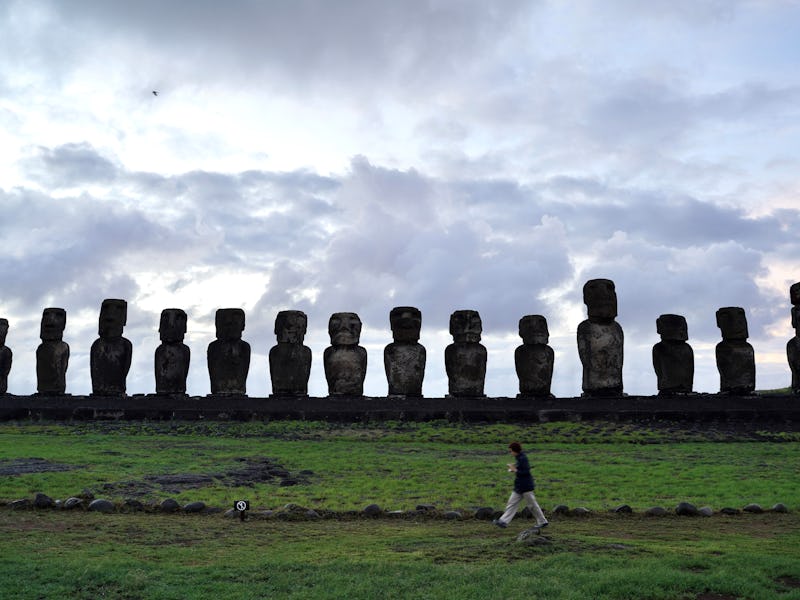A New Study Debunks A Long-Standing Myth About the Inhabitants of Easter Island
Without satellites, archaeologists would have spent years or decades searching for these clues.

The Pacific island of Rapa Nui — also called Easter Island by the Europeans that arrived there on a Sunday in 1722 — is arguably most famous for its iconic human-like volcanic rock statues called moai. But since European settlers arrived at Rapa Nui a pervasive myth has persisted: Rapa Nui’s mere 3,000 inhabitants were incapable of erecting all these moai statues. Instead, Rapa Nui must have once had a larger population that had been depleted, by about 10,000 people, due to economic collapse. Now, a novel study used satellite data to debunk this myth, and reveal new information about the Rapa Nui people.
For the study, a team of researchers combed through satellite data of Rapa Nui’s landscape for signs of rock gardening, which is a technique that transforms unproductive land into fertile soil. Rapa Nui people knew that bedrock had the ability to enrich the ground. They would break off pieces and place them on the surface and into the soil, giving the land missing minerals. Plants then could reliably grow.
The team calculated how much food those mulches could produce, and from there determined how many people could be fed. (The scientists assumed fishing resources were relatively fixed. What could vary is the amount of land crops, like sweet potatoes, the land could produce to feed the islanders.) They found the number was about 3,000 people, the same number of inhabitants the Europeans first encountered before the diseases they carried decimated the islander population. In other words, the population didn’t collapse. In fact, it was stable, thanks to their reliable agricultural techniques.
This photo taken on April 5, 2024 shows a Moai stone statue on Easter Island.
“That gives credit to the Rapa Nui people, their ancestors, and the ingenuity they had for surviving on this island,” Carl Lipo, archaeologist and professor at Binghamton University in New York, told reporters on Monday. He is the lead author of the new study, published Friday in the journal Science Advances.
“You know, 14 by seven miles doesn’t give you a lot of different things you could do with it, but they made the most of what they had. And certainly there’s a linkage of this ingenuity of carving and manipulating rocks [into moai statues] and understanding of the rock’s properties. It’s something really clearly embedded in their culture,” Lipo said. “Europeans when they arrived to this island were bewildered by the fact that there were spectacular statues and very few numbers of people. They assumed that in order to move these gigantic statues, there must have been much larger populations. Really that’s a European perspective,” he added.
A group of people visit the Tongariki ceremonial structure during the 'Pacific Leaders Summit 2024 to Protect the Oceans and Challenge Plastic and Microplastic Pollution in the Region' on Ana Kena beach, Easter Island, Chile, April 5 2024.
Satellite imagery allowed the researchers to do this debunking work faster than otherwise possible. “Satellite imagery enabled us to produce an island-wide estimate of rock mulch, where a field study would have taken years, if not decades, of walking around to map these things,” Lipo said.
Their work shows that the Rapa Nui people were likely able to sustain their population size centuries ago. But their work also looks forward.
“What inspired us to do this particular study is the fact that ecologists often continue to use Rapa Nui as a case study for collapse and ecological failure,” Lipo said. “They use it for modeling and for policy setting over and over again, which we think is really misguided. Easter Island is a great case of how populations adapt to limited resources on a very finite place and how they did so sustainably.”